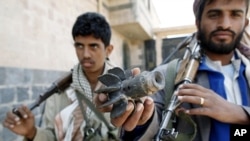|
From Jasmine Revolution to Widespread Unrest
|
- January 22: Students/protesters gather at Sana'a University, calling President Saleh to step-down.
- March 1: Tens of thousands of activists demand the ouster of President Saleh.
- March 8: The government deploys military vehicles in Sana'a, police open fire on protesters.
- March 18: Security forces fire on protesters in Sana'a, killing at least 52 people, wounding 100+.
- March 20-21: President Saleh dismisses his entire Cabinet, some senior military commanders join the protesters.
- April 2-3: Opposition leaders urge President Saleh to hand over power to VP al-Hadi, he refuses.
- April 5-8: President Saleh accepts invitation from the six-nation GCC to hold talks in Saudi Arabia with opposition representatives.
- April 10-11: GCC foreign ministers urge President Saleh to transfer his powers to his VP.
- April 14-15: Opposition leaders give President Saleh a two-week deadline to resign.
- April 17-18: Thousands demonstrate across Yemen, despite facing live ammunition from government forces.
- April 19: The U.N. Security Council meets on Yemen since the protests erupted. Russia, China reportedly prevent the council from publicly endorsing a draft statement.
- April 21-25: The GCC presents President Saleh with a plan for ending the political impasse.
- April 30-May 1: Main opposition coalition accuses President Saleh of refusing to sign the Gulf agreement, as required by the plan.
- May 15: Main opposition coalition says the GCC plan to end the country's political crisis is "dead."
- May 21-22: Opposition says it has signed a Gulf-brokered deal that would see President Saleh's transfer of power within a month. Saleh denounces the proposed deal as a "coup."
- May 23-26: Deadly gun battles break out in Sana'a between security forces, oppostition tribesmen take control of several government buildings.
- May 27: Opposition tribal leaders say they are talking with the government, cease-fire is in effect. International calls continue for Saleh to leave office soon.
- June 3: President Saleh, five other Yemeni officials are wounded in a rocket attack on the presidential compound in Sana'a.
- June 4: President Saleh's forces, oppostion forces accept a Saudi-brokered cease-fire. A truce negotiated a week earlier quickly deteriorated. Saleh flies to Saudi Arabia for treatment. VP Hadi takes over.
- June 5: Celebrations in the capital, Sana'a, after word spreads that President Saleh left the country.
- July 7: President Saleh delivers his first video address since traveling to Saudi Arabia for treatment, his faced darkened from severe burns, bandages visible on his hands.
- July 17: Tens of thousands of people rally, waving flags, chanting anti-Saleh slogans, on the 33rd anniversary of President Saleh's autocratic rule.
- July 19: Mainstream opposition coalition announce a new alliance to unite all anti-Saleh forces, days after youth groups, activists form their own 17-member "transitional council."
- August 7: President Saleh is discharged from a Saudi hospital, moved to a Saudi government residence.
- August 9: State-run news agency announces President Saleh will return to Yemen, despite international calls for him to handover power.
- August 16: President vows to return to Yemen soon, expresses a willingness to transfer power to a deputy in an effort to bring peace to the country.
- August 17: Anti-government activists meet in Sana'a, elect a 143-member "national council" that will explore ways of taking power from President Saleh.
- August 23: PM Megawar returns from Saudi Arabia, becoming the first senior official to return home after being injured in the June assassination attempt of President Saleh.
- September 12: Saleh authorizes his deputy to begin talks with the opposition, gives authority to VP Mansour to sign off on a GCC plan to transfer power, and to allow a coalition to form a national unity government. A GCC representative left Yemen with no word of a deal.
- September 18: Clashes between pro-Saleh forces and opposition forces escalate, resulting in the death of almost 100 people.
- September 23: President Saleh returns to Yemen, calling for a truce, talks to end his country's political crisis.
|
Clashes between forces loyal to Yemeni President Ali Abdullah Saleh and student protesters backed by military forces in the capital, Sana'a, left at least 40 people dead Saturday, a day after the president unexpectedly returned to the country and called for a truce.
Government forces attacked a student protest camp overnight, causing many casualties.
A spokesman for opposition General Ali Mohsen al Ahmar said at least 11 soldiers loyal to him were killed after their position came under fire.
Forces loyal to President Saleh reportedly targeted the homes of tribal leader Sheikh Sadek al Ahmar and his supporters, who no longer back Saleh.
Al Arabiya TV said the six-nation Gulf Cooperation Council appealed to "all sides to observe a ceasefire" and to "stop using heavy artillery against unarmed protesters."
The U.S. State Department has expressed deep concern about the situation in Yemen. A statement Saturday urged all parties to cease violence and exercise maximum restraint. It called on President Saleh to initiate a full transfer of power and arrange for presidential elections to be held before the end of the year.
Saleh called for an end to the fighting Friday, shortly after his return from Saudi Arabia where he was recovering from injuries sustained in a June attack on his presidential compound in Sana'a.
Follow our Middle East reports on Twitter
and discuss them on our Facebook page. |













